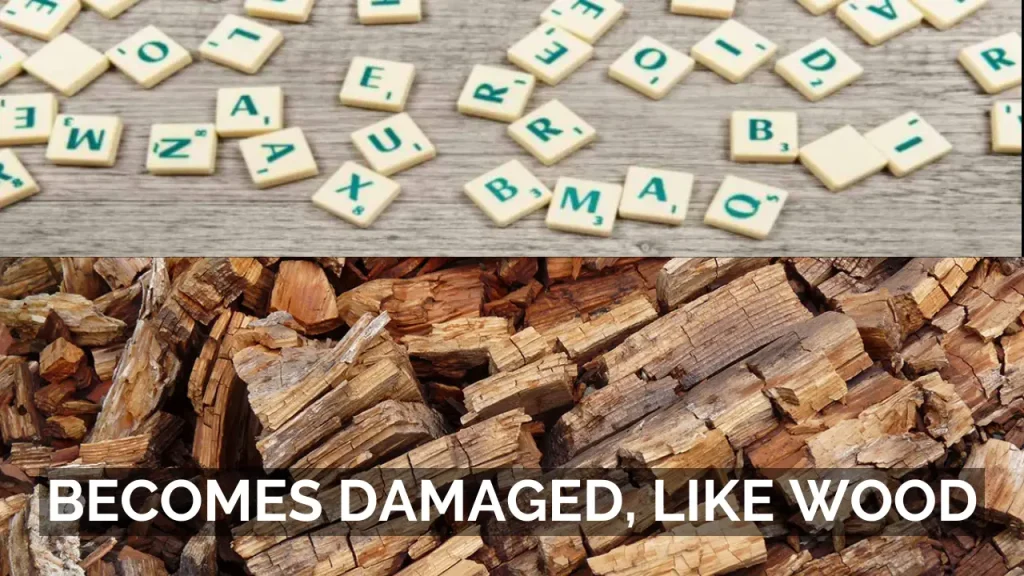
Wood is a versatile and widely used material in construction, furniture, and crafts. However, despite its durability, wood is susceptible to various forms of damage over time. Understanding how wood becomes damaged, like warping, rotting, or cracking, is crucial for maintaining its integrity and longevity.
Answer of “Becomes Damaged, Like Wood”
In the context of crossword puzzles, the clue “Becomes damaged, like wood” recently appeared in the New York Times Mini Crossword, and the ANSWER is “WARPS.”
This term specifically refers to how wood can bend or twist out of shape, but there are many other ways wood can become compromised.
Common Types of Wood Damage
Warping:
What is Warping? Warping occurs when wood absorbs moisture unevenly, leading to bending, twisting, or cupping. This is particularly common in environments with fluctuating humidity and temperature levels.
How to Prevent Warping:
- Store wood in a controlled environment before use.
- Seal wood surfaces to prevent moisture absorption.
- Use kiln-dried wood, which is less likely to warp.
Rotting:
What is Wood Rot? Wood rot is caused by fungi that thrive in moist conditions, breaking down the fibers of the wood. There are two main types: dry rot and wet rot.
Preventing and Treating Rot:
- Keep wood dry and ensure proper ventilation.
- Treat wood with antifungal solutions.
- Replace severely rotted sections to prevent further spread.
Splitting and Cracking:
Causes of Splitting and Cracking: Wood can split or crack if it dries too quickly or if it experiences uneven pressure. This damage is often seen in wooden furniture and structures exposed to harsh conditions.
Prevention Tips:
- Gradually acclimate wood to the environment where it will be used.
- Use wood fillers and sealants to repair minor cracks.
Insect Infestation:
Common Wood-Damaging Insects: Termites, carpenter ants, and beetles can cause significant structural damage by burrowing into wood.
Signs and Solutions:
- Look for tiny holes, sawdust, or weakened wood as signs of infestation.
- Use insecticides or professional pest control services to eliminate pests.
Staining and Discoloration:
How Does Staining Occur? Staining and discoloration can result from exposure to water, chemicals, or prolonged sunlight. These factors can alter the wood’s appearance and weaken its structure.
Prevention and Restoration:
- Apply protective finishes to shield wood from external elements.
- Sand and refinish stained areas to restore the wood’s natural look.
Causes of Wood Damage
- Environmental Factors: Wood is highly sensitive to environmental conditions such as humidity, temperature changes, and UV exposure. These factors can weaken wood over time, leading to various forms of damage.
- Poor Maintenance: Neglecting regular maintenance, such as sealing, cleaning, and inspecting wood, can accelerate damage. Proper care is essential to preserving wood’s strength and appearance.
- Improper Installation: Incorrect installation or handling can lead to stress on the wood, resulting in warping, splitting, or other damage.
- Biological Factors: Fungi, mold, and insects are biological agents that can degrade wood. Moist environments are particularly prone to these issues, making it crucial to keep wood dry and well-ventilated.
Prevention and Treatment
- Proper Sealing and Finishing: Applying sealants and finishes creates a protective barrier that prevents moisture and UV damage. Regularly reapplying these finishes ensures long-term protection.
- Regular Maintenance: Inspect wood regularly for signs of damage and perform routine maintenance, such as cleaning and resealing. This helps catch issues early and prolongs the wood’s life.
- Environmental Control: Keep indoor environments with wood at a stable humidity level and avoid placing wood in areas with extreme temperature changes.
- Treatment Options:
- For Warping: Use clamps or weights to gently reshape warped wood.
- For Rotting: Remove and replace the affected areas with new wood.
- For Insect Damage: Apply insecticides or hire pest control professionals to eliminate infestations.
Conclusion
Wood damage is a common issue that can arise from various factors, including environmental conditions, biological agents, and improper care.
By understanding the causes and implementing preventative measures, you can maintain the beauty and structural integrity of your wooden items for years to come.
For those interested in crossword puzzles, the clue “Becomes damaged, like wood” is often answered with “WARPS,” reflecting just one of the many ways wood can be affected.


